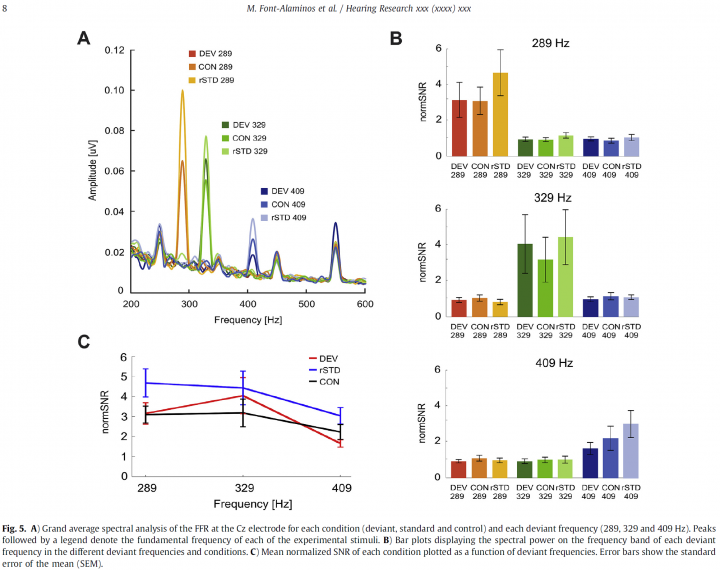The paper entitled Emergence of prediction error along the human auditory hierarchy, by Font-Alaminos, Ribas-Prats, Gorina-Careta, and Escera has been published in the journal Hearing Research.
In this study we had the double aim of a) finding evidence of prediction error in the human subcortical system, and b) prediction error would be modulated by the magnitude of error both in cortical and subcortical neural networks. Former evidence from our lab in animal models demonstrated that prediction error emerged gradually from the inferior colliculus towards the auditory cortex of rats and mice (Parras et al., 2017), and previous studies suggested that prediction error signals at cortical levels remained similar irrespective of the magnitude of change with regard to repeating stimulation (Hórvath et al., 2008). Here we could replicate this latter finding and found no traces effects of predictions on the frequency-following response (FFR), an auditory evoked potential with main generators in the subcortical auditory system.
The full abstract reads as follows:
Auditory prediction errors have been extensively associated with the mismatch negativity (MMN), a cortical auditory evoked potential that denotes deviance detection. Yet, many studies lacked the appropriate controls to disentangle sensory adaptation from prediction error. Furthermore, subcortical deviance detection has been shown in humans through recordings of the frequency-following response (FFR), an early auditory evoked potential that reflects the neural tracking of the periodic characteristics of a sound, suggesting the possibility that prediction errors emerge subcortically in the auditory pathway. The present study aimed at investigating the emergence of prediction error along the auditory hierarchy in humans through combined recordings of the FFR and the MMN, tapping at subcortical and cortical levels, respectively, while disentangling prediction error from sensory adaptation with the use of appropriate controls. “Oddball” sequences of pure tones featuring repeated “standard” stimuli (269 Hz; p=0.8) and rare “deviant” stimuli (p = 0.2; of 289, 329 and 409 Hz delivered in separated blocks to test “frequency separation” effects) were presented to nineteen healthy young participants. “Reversed” oddball sequences (where standard and deviant tones swapped their roles) were presented allowing comparison of responses to same physical stimuli as a function of functional role (i.e., standard, deviant). Critically, control sequences featuring five equiprobable tones (p = 0.2) allowed to dissociate sensory adaptation from prediction error. Results revealed that the MMN amplitude increased as a function of frequency separation yet displayed the same amplitude when retrieved against the control sequences, confirming previous results. FFRs showed repetition enhancement effects across all frequency separations, as supported by larger spectral amplitude to standard than to deviant and control stimuli. This pattern of results provides insights into the hierarchy of the human prediction error system in audition, suggesting that prediction errors in humans emerge at cortical level.
Reference:
Font-Alaminos, M., Ribas-Prats, T., Gorina-Careta, N., & Escera, C. (2020). Emergence of prediction error along the human auditory hierarchy. Hearing Research, in press.
Permanent doi: https://doi.org/10.1016/j.heares.2020.107954.


